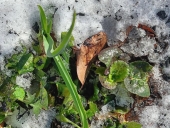We had a hard summer, with too much going on and some family stuff, which meant I didn't get all my seeds started and transplanted out in time for a good winter garden this year.

Here's what's working anyway, that have been thriving despite more neglect than usual:
- Chard,
Bietola a costa fine, an Italian heirloom that has more or less become perennial in my garden. (Berkeley hills, very mild winters.)
- a pretty purple kale (I think it's
this one from Wild Garden Seed) that's still going strong about 18 months after being planted out.
-
Mizspoona, originally from Adaptive seed, but I've been saving seed of my own for a few years now, always saving from the plants that are last to bolt. Now, many of my mizspoona plants last around a year or so before bolting. It's by far the easiest green I've ever grown.
- Lamb's lettuce / corn salad / mache, which has been self-seeding for a few years now, and always appears just after the rains start. It's not much in terms of volume, but it's tasty!
- Alexander's, which I'm trying harder to like. I love it as a plant - so productive and beautiful, but I haven't warmed up to the flavor yet. Anyone have any recommendations for how to prepare it?
- Parsley
- Perennial herbs that are pretty much always available for harvest year round, and find their way into cooking most days: winter savory, Syrian oregano, marjoram, bay leaves - which we have by the armload because the bay trees are borderline pests, mint
- beets
- lemons
- lettuce












